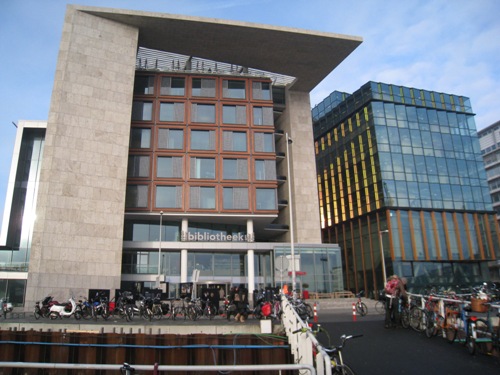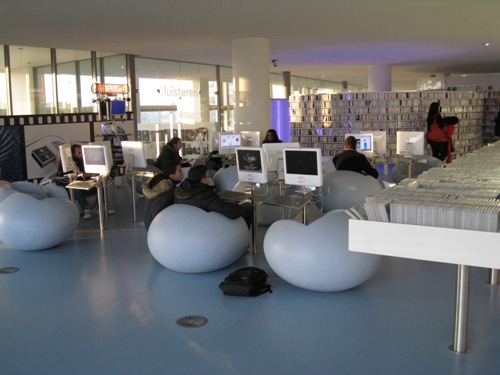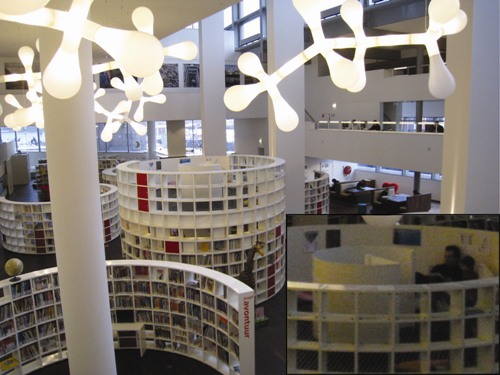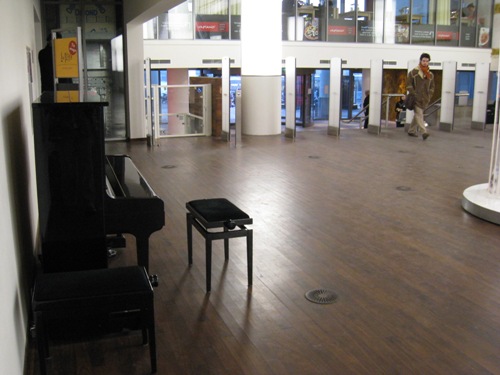
Editor’s Note: Fred Sztabinski is a Spacing contributor and former project coordinator of TCAT who recently relocated to Amsterdam, Netherlands. He will write occasional blog posts for Spacing comparing Toronto and European urban landscape issues.
– – – – – – – – – – – – – – – – – –
AMSTERDAM — Working from home, it’s often nice to go out and do a bit of work “off-site,” just to mix things up and, at the very least, remind yourself that there are other people out there. For me in Toronto, a café was the go-to place for this. But in Amsterdam it’s not as easy to find a place where you can order a latté and just sit for a while reading or on your laptop. Those types of places do exist here, but they’re not as common as in North America or other European countries, and en route to finding one you probably want to avoid what’s actually called a café (a restaurant/bar) and a coffeeshop.
I’ve recently discovered Amsterdam’s new Central Library (or Openbare Bibliotheek) and it truly is a great place to visit, for work or otherwise. The building is architecturally striking and the spaces very creative. This got me thinking that, as the Toronto Reference Library (or possibly the future Jane Jacobs Reference Library) is set to undergo a major revitalization, I really hope we might see some of what Amsterdam’s got in its showpiece library.
Opened in 2007 and touted as the largest public library in Europe, it is centrally located within a short walking distance of Central Station. The building was designed by famed Dutch architect Jo Coenen and is just one of a number of modern buildings filling up reclaimed land along the former docklands of Amsterdam’s waterfront. Coenen is also responsible for the master plan of KNSM Island (look out for a future post on this fully planned modern island development).

The library has a great variety of work spaces and internet-ready computers free for visitors to use, as pictured above in the library’s mixed media area. And there’s no need to reserve a computer or wait in line – there’s always a few machines open. The library offers free wi-fi internet access as well.
Offering spaces like this to students, self-employed individuals, and visitors to your city is a great economic development tool, in my opinion. The space breeds creativity and interaction, all within a knowledge centre not matched by too many other places. Cities should – and many already do – realize that a public library is more than just a book lending service to its constituents; it can also be an investment in its culture and work force.

Pictured above is the children’s area of the library on the ground floor. I find this space really attractive as it’s so open and full of light. In the inset photo you’ll see that there is a staircase that leads to a reading nook atop the circular tower of book shelves in the centre of the photo.

Perhaps one of the most pleasant things about the library is the piano in the main foyer. It’s free for anyone to use – up to a maximum of 30 minutes. Sporadically while I’m there someone will decide to tickle the ivories and you can hear the music waft throughout the building. Obviously, not your typical “Shhhhh, quiet please!” library mentality.
The library also has three restaurants, including a rooftop “marché-style” restaurant with patio seating overlooking the city.
This truly is a place worth visiting and something Amsterdammers are lucky to have. The Toronto Reference Library is a gem itself, designed by an equally famed architect, Raymond Moriyama, and with the upcoming revitalization I believe it could soon be on par with the Openbare Bibliotheek Amsterdam.




9 comments
It’s interesting to see that designing a library around an open central atrium is still state of the art. It must have been a revolutionary idea in its first use — come to think of it, was ours the first? If not, it was certainly ahead of its time.
Unfortunately, that also means we probably won’t see something with the same contemporary flare as Amsterdam’s central library, the new one in Seattle, etc. I welcome the renovations but wouldn’t want the TRL completely ripped apart to make it look like a brand new 21st-century building. But we do have a remarkable branch network of old, new, and newly-renovated libraries, so I don’t think we have to worry about keeping up with the Joneses.
Matt, the sentiment often expressed here is that the TPL is the municipal agency that can do no wrong. The renderings I’ve seen of the TRL keep everything generally intact, with the main additions on the back at the east side, as well as a new multi-floor glass entrance….unless plans have changed, most of the familiar part will stay the same, simply cleaned up. An interesting x2 floor open area (a sort of mini-atrium) is planned on the 4th & 5th floor (again, if I recall correctly — been 1.5 years since I saw the pics).
Shawn, thanks for the details. I agree with the sentiment about TPL and have expressed it here before. I was more responding to the sense I got from Fred’s post of a hope that the TRL would have the same sort of “wow” factor as the new Amsterdam library. I’m just not sure that’s realistic with a mid-life, mid-sized reno project.
Because TRL isn’t in need of total gutting or replacement, the TPL has also been able to invest in the rest of its branch network. There are little architectural gems scattered across the city — from the historic Beaches branch to art deco touches at Long Branch to a strikingly contemporary little branch in Eatonville. So even if we don’t have the newest, shiniest central library, Torontonians shouldn’t feel we’re somehow falling behind.
York University’s Scott Library has a central atrium, although it’s a lot more closed off than the Toronto Reference Library.
Scott opened some time prior to 1977, but I can’t seem to find the info online. The first York U building boom ended in the early 1970s, so I would guess a date of about 1972 for Scott.
Matt, just a note of clarification on my post: In terms of the revitalized TRL taking on elements I found in Amsterdam’s Central Library, I’m much more interested in the softer, program elements than the architecture. Yes, the OBA is impressive, but I agree we don’t need a total make-over in Toronto when we’ve got a gem of our own, as I mention. Things like a larger supply of internet-ready computers, a café or restaurant, cozy and comfy places to read, and even music would be great.
I don’t know how eager I would be to have a piano in the foyer. Maybe if I was more fond of hearing Chopsticks and/or Heart and Soul over and over…
Ah, let me just take a sec to toot a horn for another library a lot closer than Amsterdam: Montréal’s new Grande bibliothà ¨que.
If you take the tour and watch the film about building it, you see what and incredible amount of care went into making it useful and beautiful (and surprisingly airy thanks to its atrium). Plus it was built incredibly cheaply, thanks in great part to Lise Bisonnette, an important mover and shaker here previously with Le Devoir newspaper.
Little touches like in-floor ventilation and such (easier to work on for repairs), child-height ramps on the stairs down to the children’s section, a variety of seating places for different tasts, such as big open areas or little opera-box type “loges” with a view out over the rooftops of the Latin Quarter. It has a little café/restaurant and meeting rooms and study rooms and a theatre and tons of listening posts and a cinema and a job centre and and exhibit space and nifty glass elevators and lots and lots of books. Its front hall was designed in keeping with the underground city idea of letting people pass through buildings to get somewhere — in this case, out to a little artsy garden or to a little alley that leads to St-Denis street. Plus the rest of the library can close but the front section that faces the street, with magazines and new releases section and your reserved documents remains open until midnight, how useful.
They also beefed up the computer system significantly, with an extensive catalogue, list of activities, online reservations, automated overdue reminders by phone, self-serve check-out…
They were expecting 5,000 users a day, and they average 10,000, which sure sounds like a success to me. It helps that it was built connected to the main métro stop and right across from UQAM university.
Oh, and no piano.
http://www.banq.qc.ca/documents/a_propos_banq/nos_publications/nos_publications_a_z/Here_is_your_Grande_Bibliotheque.pdf
I visited the OBA in the summer and was very impressed with its design and functionality. I think some of the elements you talked about are reflected in a lot of modern Dutch architecture. Even in their homes the emphasis always seems to be on large windows, exposure to light and airy colours. The Dutch also should be noted for having a cafe in every public building. During my experience there I noticed that a cafe serving coffee, soup and sandwiches was a necessity in every public building. Every university building had at least one, city hall had several and even smaller branch libraries had cafes that could rival the floor space of the library itself.
The placement of the OBA was also interesting as they have placed it between the Central Train Station and the developing areas along the waterfront, maybe as a catalyst to try and bring people into these new areas. The Dutch seem very good at doing urban planning within larger contexts.
Hi fellow Torontonians,
I am from Toronto, and currently live in Amsterdam. I came here as a student in 2007, and gravitated towards the well designed OBA institute. While I agree with the strong points, as highlighted by the author, free wi-fi, relevant exhibits, a swank yet affordable cafe, something this place sorely lacks is free bathrooms.
At the very least, bathrooms on every floor. While this might seem like a minor oversight, a major drawback for me to study at this library is that every time you need to go to the washroom, you must descend, sometimes 6 floors, to the basement and pay 50 Euro cents every time. This is a major inconvenience because you can lose your spot studying. Another poorly designed component is side study rooms/cubicles that one can reserve.
On the other hand, they do have a fantastic CD and video rental programme, for 1 Euro a week you can borrow the latest foreign movies. A drawback to being part of the library system, which is not noted by the author is that if you want to be a permenant member of the library (to take out books, CDs, and videos) you actually have to have a legit/valid Amsterdam address, which most nomadic student/workers are unable to secure.
Some food for thought. While living with my ‘rents in Unionville, there was a fantastic library in the boonies in the Angus Glen Community Centre. Free wi-fi in 2006, ability to reserve study carrels, free bathrooms on every floor, a cheap cafe, and free CD and independant DVD loans… I think we as GTA-ers need to also commend our own well designed libraries. However, a scaling up would be in fine form these days because the Toronto’s library flagship at Bloor & Yonge is in dire need of revamping… http://commons.wikimedia.org/wiki/Category:Angus_Glen_Community_Centre
Michelle